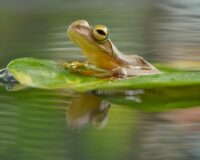African dwarf frogs are fully aquatic creatures, meaning they live their entire lives in water and rely on it for survival. Despite having lungs and being able to surface for air, these frogs cannot survive outside of water for long periods. A common misconception among new frog owners is that, like some amphibians, African dwarf frogs can adapt to short spells on land. However, this misunderstanding can be fatal.
These tiny amphibians have delicate, permeable skin that needs constant moisture to function properly. When removed from water, their skin begins to dry out quickly, leading to stress, dehydration, and ultimately death if not returned to their aquatic environment. Unlike semi-aquatic frogs, African dwarf frogs are not designed for land movement and can easily become injured or trapped in dry conditions.
This blog post explores the critical importance of maintaining a fully aquatic habitat for African dwarf frogs. We’ll cover what makes their biology so dependent on water, the signs of dehydration or stress when they’re out of their environment, and tips for safely handling them (if necessary). You’ll also learn about the best tank conditions to prevent accidental escapes and ensure their environment mimics the safety and stability of their natural habitat.
Whether you’re a new frog keeper or a curious enthusiast, understanding this vital aspect of African dwarf frog care is essential for their well-being. Keeping them submerged in clean, temperature-controlled water isn’t just a preference — it’s a necessity. In this article, we’ll debunk myths, offer practical advice, and help you create a safe, happy home for your tiny aquatic companions.
Stay informed, and protect your frogs — because yes, they can drown if removed from water.






